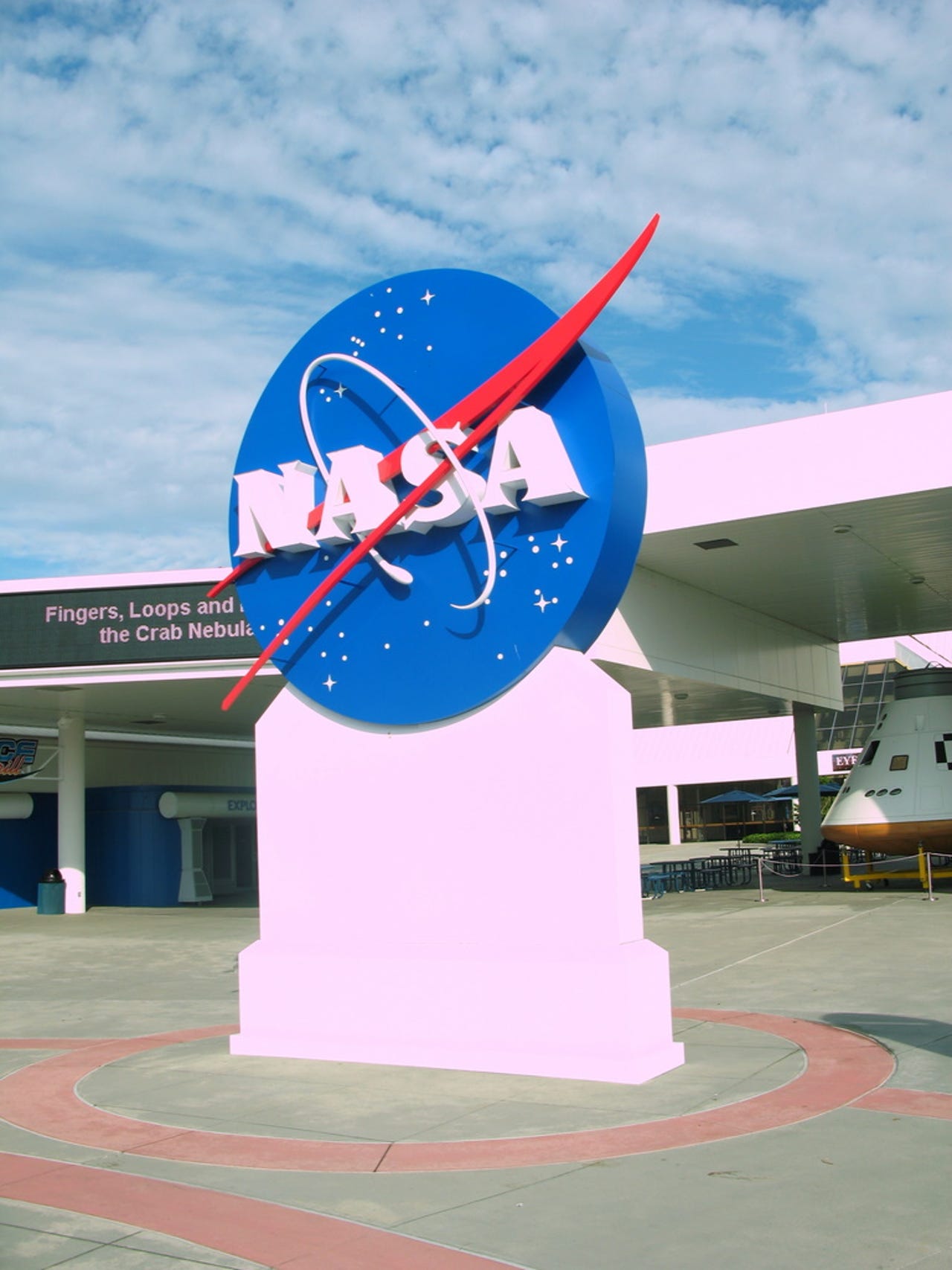Kennedy Space Center


In early January 2009, my wife Rachel and I visited Kennedy Space Center, on Merritt Island and Cape Canaveral, Florida. The Kennedy Visitors Center is a totally renovated new facility that is privately funded and has lots of great exhibits of classic NASA artifacts.
A panoramic view of the Early Space Program exhibit at the KSC Visitor's Center.
Here's a good view of several of the rockets -- from left to right, Mercury, Gemini/Atlas, Agena.
The Atlas/Agena launch vehicle was used during the Gemini program in the mid-1960s to launch the Agena docking module/upper stage into orbit.
This is the business view of the RS-24 Space Shuttle Main Engine exhaust. Capable of 400,000lbs of thrust, the Shuttle has three of these on board.
This is a long distance view of Launch Complex 39A, one of the two large manned launchpads at Kennedy Space Center. Pad 39A and Pad 39B are approximately 8000 feet apart, and safe viewing distance for liftoff is 5 miles.
Space Dot Ice Cream, served in a plastic astronaut helmet. I highly recommend the Sugar-Free vanilla, flavored with Splenda.
You think your IT consulting contract is stressful and your work conditions stink? Try these IBM contractors on for size, who had to support the Apollo program. "Failure Is Not An Option" should be a source of inspiration for anyone who works in technology today. These are the actual workstations at the completely renovated Apollo mission control, which is a completely immersive multimedia experience that simulates an Apollo launch. It's awesome.
KSC has also renovated and moved the mission control for Mercury and Gemini into the Visitor Center. Man, I love these winky blinkies.
This is the rear end of the Saturn V Rocket's primary ascent stage. There are five Rocketdyne F-1 RP1 kerosene-fueled rocket engines here. Each F-1 can produce 1,522,000 of thrust. The F-1 was the most powerful rocket engine ever used in service.
The Saturn V Stage I. The enormity of this rocket is difficult to depict in this photo. The most complex machine man has ever produced, it was 363 feet high, and took men to the moon.
This is the rear end of the Saturn V Rocket's secondary booster stage. There are 5 J-2 hydrogen-fueled rocket engines here. There is a single J-2 on the third stage of the rocket, which was used to push the command module and Apollo capsule out of earth orbit. Each J-2 can produce 250,000lbs of thrust. Interestingly, an advanced version of the J-2 will replace the Space Shuttle Main Engines (SSMEs) that were going to be re-purposed for the Constellation/Ares program. Why the J-2? It's less than half the price of an SSME, which was designed to be re-usable. The J-2X variant will produce 294,000lbs of thrust, and the Ares booster will only be carrying one for it's Earth Departure Stage on the Ares I manned rocket -- just like the third stage of the Saturn V. For primary ascent the Ares I will use an updated version of the Space Shuttle Solid rocket booster (SRB). The main boost stage on the heavy-lift Ares V variant for moving large cargo items into space will use five RS-68 engines, which are used on the Delta-IV unmanned rockets, and will also use the J-2X on it's Earth Departure Stage.
This Lunar Lander was originally slated for a later Apollo mission after Apollo 17, but was never used.
This Lunar Rover was used for Earthbound training of the astronauts. It's fitted with tires and suspension for Earth use, but otherwise, it's nearly identical to the one that the astronauts drove on the moon.
This is a pristine Apollo capsule mounted on a Apollo command module. The Orion/Constellation program that will replace the Space Shuttle will build upon this technology -- it will be larger and seat 4 astronauts rather than 3, and will be used to send us back to the moon as well as be used for orbital Earth missions.
Here's the nose cone view of the Saturn V.
Here's a Soviet-Era Soyuz spacecraft. This one is decked out with the modifications for the Apollo-Soyuz Test Project, which was undertaken during the 1970's after the Apollo program to test docking maneuvers and is considered the prelude to today's International Space Station project. The Soyuz capsule is still used today as the primary space platform by Russia and is considered to be a very reliable system. The Soyuz has undergone six generations of improvements and is the most proven manned spacecraft in history.
We were able to check out the International Space Station Center on NASA's closeup tour and were escorted into secure areas. Still, this sign gave me the heebie-jeebies.
Here's the gangplank leaving the Visitor Center area leading to the ISS Center.
The interior of the ISS Center, where the components of the International Space Station are constructed. In the foreground is a cylindrical supply module which is used to re-supply the space station with food, water, and other consumables. In the background a Japanese science package is being worked on, and it is a separate secure area.
Here's the Japanese working on their science platform.
Here's a better view of one of the supply modules.
A side view of the ISS Center. Can you see how the fencing is curved? That's because Kennedy Space Center is on a swamp preserve, and there are alligators EVERYWHERE. Alligators can easily jump fences, so they shaped them this way so they fall back and flop over. The employee parking lot, however, has no such protection, so its not uncommon to see alligators in the parking lot and other facilities, and for animal control to remove them.
You think having to use aircraft restrooms is uncomfortable? Try this zero-G toilet on the ISS.
On the second day we returned to the KSC, the Space Shuttle Discovery had been rolled out to Pad 39A just the night before. This is as close as most people can get to the shuttle while it is on the pad, about 1 mile away.
Here's a closer view of one of the other pad, not currently occupied, Pad 39B, with its gantry clearly visible.
This is the Vehicle Assembly Building, which was built for the Apollo program. The building is over 550 feet tall, and is one of the largest buildings built by man by volume, not by height. It was intended to house the giant Saturn V rocket standing straight up. Today it is used for the Shuttle program and will be re-used for Constellation/Ares.
This giant NASA logo on the VAB required over 700 gallons of paint.
One of the two giant crawler transporters which was designed in the 1960s to move the Saturn V rockets to the two LC-39 pads. Today it is still used to move the shuttle out on the crawlerway for launch.
The Shuttle Landing Facility is located in the Kennedy Space Center, and is the primary landing site for the shuttle. The landing strip is one of the longest in the world, and is over 15,000 feet long.
This Coca-Cola dispenser, on display at the Astronaut's Hall of Fame, near the Kennedy Space Center, was used aboard a single shuttle flight.